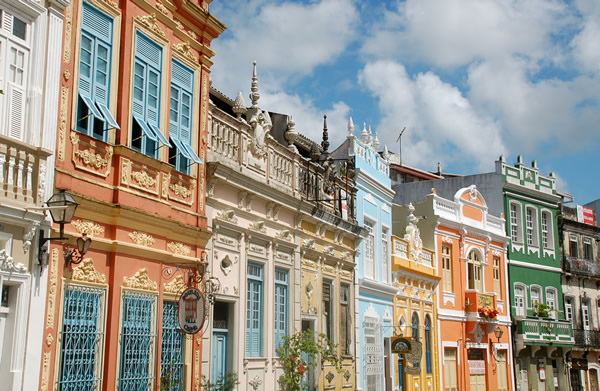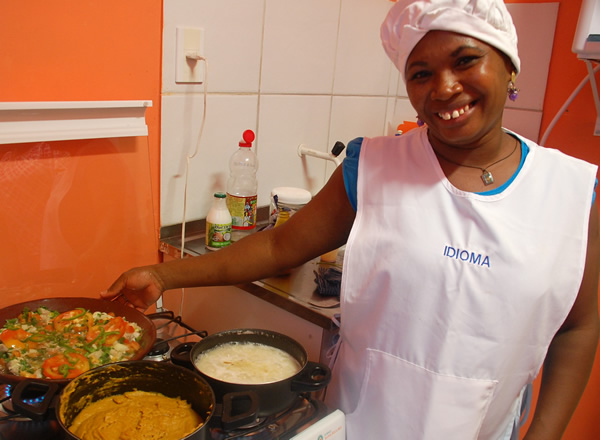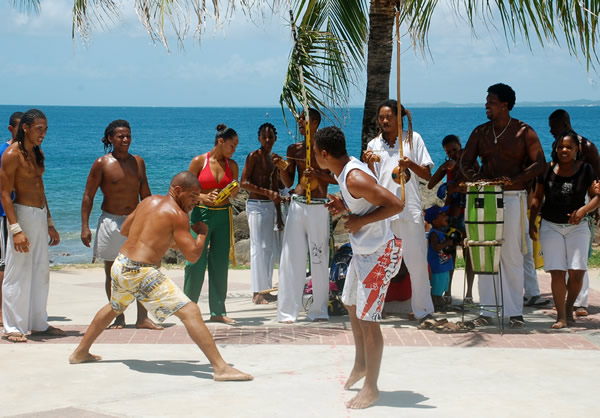How and Where to Study Portuguese in Salvador da Bahia, Brazil
Article and photos by Lies Ouwerkerk
Senior Contributing Editor

|
|
The Pelourinho district in Salvador, Brazil.
|
Getting by in foreign tongues has always served me greatly in connecting with local people and their culture during my travels. It helps, of course, to have lived in Europe, where I was exposed to several foreign languages. Portuguese, however, was never one of them. So when I recently embarked on an extensive trip through Brazil, I decided to start with a full immersion experience for the first few weeks of my travels, taking Portuguese classes in a language school, combined with a homestay at a Brazilian family.
Choosing a Venue and Keeping the Money Local
The question is always, how to choose the right school? After defining my most important criteria and researching the options on the Web, I was able to narrow my search down to a few schools of interest. For one, I always make a point of using the services of locally-based enterprises whenever possible, in that way ensuring that my money stays in the visiting country rather than going to international organizations employing locals for a fraction of the benefits.
Salvador da Bahia stuck out because of its reputation of being a city of music, festivals, impromptu fests, and traditions with a strong African influence. Moreover, pictures of Salvador’s old colonial district, the Pelourinho, declared World Heritage Site by Unesco in 1985, seemed very alluring. The fact that endless beaches, idyllic islands, hiking-friendly national parks, and scenic colonial towns were all within relatively easy reach of Salvador, definitely added weight too.
In the end, I zoomed in on language school IDIOMA because of their affordable school fee, half-day classes, availability of homestays within walking distance from school and beach, and pre-arranged pick-up from the airport.
The Language Program
At IDIOMA, located on a small residential street in Salvador’s Barra district, it is possible to start classes on any given Monday, whether in small groups or 1-on-1, at any level of proficiency or special interest, and with a choice of two, four, or 6-hour sessions a day.
A quick evaluation by very welcoming staff members determined my place in a small beginners group of five, all having a good command of Spanish and thus sharing some advantages (reading) and disadvantages (pronunciation).
Conversational Portuguese, especially as related to situations with which we could easily identify, was definitely the mainstay of our program. But we also received grammar instructions, and listened to songs of prominent composers and vocal artists like Tom Jobim, Chico Buarque, Caetano Veloso, and Gilberto Gil. Soon we were able to read poetry and short articles on cultural and social aspects of Brazilian society, and to participate in role plays, games, and discussions. The ages of the participants varied from 20 to 70, and the difference in age and life experience made our discussions all the more lively.
The Bahian Kitchen

|
|
Cooking class of local foods at IDIOMA.
|
IDIOMA offers complimentary activities including dance classes, diving lessons, folklore evenings, and Bahian cooking. Joining Nalva’s cooking classes a few afternoons a week proved to be a great opportunity to learn how to prepare (and eat) Bahia’s famous dishes like moqueca de peixe, a fish stew prepared with the indispensable dendê (palm) oil and coconut milk, and to get familiar with Brazilian kitchen lingo.
Since breakfast was included in the homestay arrangement, my charming hostess Dolores, who lives with her sister Valdete in a high-rise building towering over Barra beach, the historic forts, and the Atlantic Ocean, prepared every morning tantalizing breakfast dishes such as my favorite torta de banana (banana pie), bolo bahiano (coconut cake), and pao de queijo (cheese bread).
After our morning classes, we would usually have lunch with a small group of students in one of the typical comida a kilo (food by weight) restaurants around the school, where we would stack up on salads, seafood, and fruits, for around $5 or even less. And of course, we also had to try acarajé, Bahia’s well-known fast food, made of black-eyed peas, onions, and dried shrimp, and prepared by the baianas in their stands along Avenida Oceanica.
More than once, we had dinner in one of the cozy eateries in the vibrant but noisy and tourist-oriented Pelourinho, where narrow cobble-stoned streets lined with shops, bars, and open restaurants, as well as monuments, pastel-hued mansions, and baroque churches are still testimonials of Portugal’s colonial glory days. Often, from our terrace seats, while sipping a capirinha (Brazil’s “national cocktail”), we would witness an impromptu street concert or capoeira performance (an Afro-Brazilian form of martial arts, combining self-defense, acrobatics, dance, and music). Or we would see a group of residents marching through the neighborhood, dancing in trance on the beats of the drums leading the pack.

|
|
Capoeira demonstration at the beach.
|
Festivals in Salvador, Brazil
In fact, Salvador seems to be constantly “on fire” with religious, folk, or popular festivals, nearly always ensuing in street parties with plenty of beer, music, and dance until deep into the night. Although the southern hemisphere’s summer months can be hot at Bahia’s coast, it is definitely the best time of the year to visit Salvador, since many festivals take place in January, February, and March.
First of all, there is the Processao do Senhor Bom Jesus dos navigantes (Procession of Our Lord of the seafarers) on January 1, when hundreds of vessels sail the picturesque All Saints Bay.
On every second Thursday of January, the day of the Lavagem do Bonfim, a 10 km (6 mile) procession of people dressed in white with many beaded necklaces, marches towards the church of Nosso Senhor do Bonfim where Bahian women will empty their aromatic water pitchers on the steps of the church, overseen by Catholic priests and Candomblé priestesses. The carnival group Filhos de Ghandy marches right behind the baianas and sprays and splashes onlookers with cologne for good luck, while many young vendors try to sell Bonfim ribbons in all colors of the rainbow. According to an old tradition, tying such a ribbon around the wrist grants the wearer three wishes, which will come true by the time the ribbon falls off. Taking off the ribbon, however, may invite bad news.
On February 2, as an offering to Yemanjá, goddess of the sea, boats filled with flowers, bottles of perfume, cakes, and notes asking the goddess to grant a wish, are pushed into the sea at Praia Rio Vermelho, to be unloaded further in the ocean. Yemanjá is a spirit of the Yoruba, whose religion was brought to Brazil from Africa in times of the Atlantic slave trade, and then fused into the Candomblé religion which is still practiced widely in Brazil, especially in the Bahian Candomble houses.
Finally, Salvador’s carnival takes place in late February or early March, and is considered “world’s largest street party” by many insiders — even surpassing the one in Rio — because it spreads out over a large part of the city, and welcomes anyone to join in. Nota Bene: beware of pick-pocketing, especially at large gatherings, and only carry necessary change!
Around Salvador
Since most of IDIOMA’s classes are in the morning, I could leave for 3-day weekend trips to destinations outside Salvador, with buses leaving from the rodovaria (bus station), some 10 km east of the city centre. Praia do Forte is a pretty resort town, just a 2-hour ride north of Salvador, with a 12 km (7 mile) long beach, plenty of nightlife, and a worthwhile sea turtle station. Land inwards, the colonial mining town of Lençois, a 6-hour drive from Salvador, and set in the magnificent nature of the Chapada Diamantina, is an ideal destination for hikers.
Morro de São Paulo and Boipeba to the south are lovely island retreats. Since you need to use a combination of bus and boat connections to reach them, and then proceed on foot, it takes longer to get to the final destination, so I tagged the islands onto the end of my stay in Salvador.
Moving On
With the basics of the Portuguese language I had learned at IDIOMA, the coaching by my host family on safety and Brazilian customs, and the day-to-day exposure to Brazil’s food, public transport, and currency, I felt comfortable enough to travel through the rest of the country on my own. Never would I have thought that in a few weeks time, I could master enough Portuguese to effortlessly buy bus, plane, and concert tickets, ask for hotel rooms, toilets, or general directions, negotiate taking pictures of locals, strike up random conversations, and partake in community activities, especially in Brazil’s interior and on the island, where not a lot of English is spoken.
Website
ICI Instituto Cultural IDIOMA Brasil
Fees
1-week group classes: about $200, depending upon length of stay and intensity; The homestay including breakfast at $24 per night. IDIOMA also facilitates stays in apartments, pousadas, and hotels. Please ask for quote on the latest price updates.
Lies Ouwerkerk is originally from The Netherlands, and currently resides in Montreal, Quebec. She works as a columnist for The Sherbrooke Record, and as a freelance writer and photographer for various travel magazines.
|
